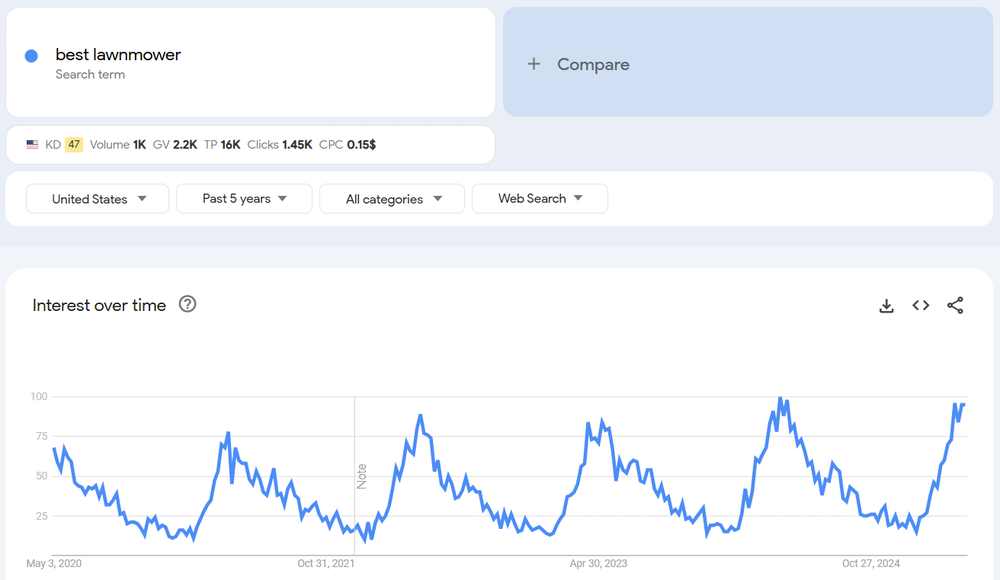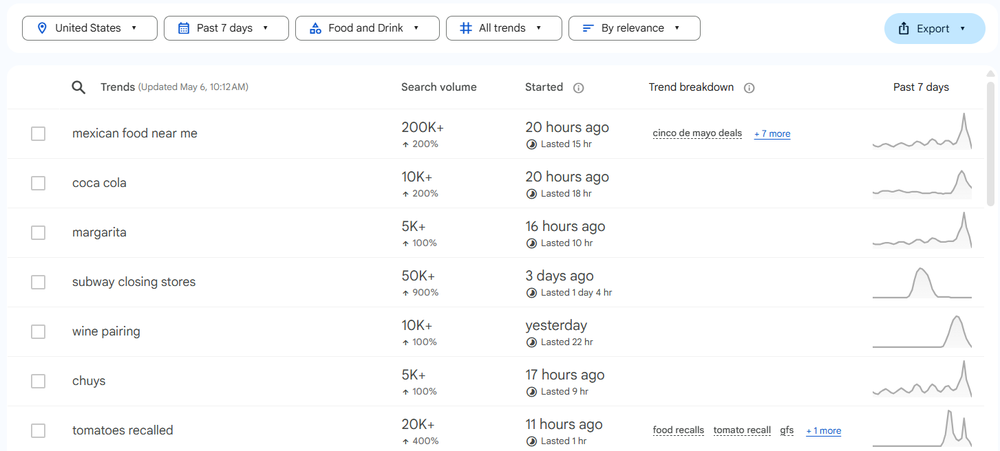Getting Ahead of the Curve: How Google Trends Can Be Used to Discover Emerging Topics Before They Go Viral Spotting upcoming trends before they blow up can be a powerful opportunity to be at the forefront of the noise before the competition gets there.
By Dmytro Spilka Edited by Jason Fell
Opinions expressed by BIZ Experiences contributors are their own.
You're reading BIZ Experiences Europe, an international franchise of BIZ Experiences Media.

Google Trends is a great tool that gives insights into Google search usage. With valuable insights at the click of a button, businesses can create strategies that are designed to target topics at their peak. And perhaps best of all, it's free.
Let's explore what exactly Google Trends is and how it can be used to find emerging topics before they go viral.
What is Google Trends?
Google Trends is a tool that analyzes search queries to identify any trends in the data. It can be used to gain a better understanding of search behaviors over time, allowing marketers or business owners to identify trends that can help fine-tune their strategy.
Google Trends 'Explore' tab
The Explore feature is used to calculate how many times a search term has been entered into Google over a specified period, producing a line graph to create a visual representation.
Let's look at an example. The image below shows the results for a Google search of "best lawnmower." Over the past five years, a noticeable trend is evident, with the search term being used significantly more during spring and then gradually declining until autumn. This insight would be helpful for businesses such as retailers or landscapers who are wondering when the best time is to target consumers looking to improve their gardens.

As well as providing a graph of how often the search term is used over a defined period of time, there is a range of statistics available that relate to the keyword.
- KD (keyword difficulty): A numerical score that shows how competitive the keyword is – in other words, how many other websites are trying to target the same term.
- Volume: An average of how many times the particular keyword is searched on Google every month in the US.
- GV (global search volume): An average of how many times the particular keyword is searched on Google every month across the world.
- TP (traffic potential): The sum of organic search traffic that the #1 ranking page for the target keyword receives from all the keywords that it ranks for.
- Clicks: An estimate of how many monthly clicks are made in the search results for a particular keyword.
- CPC (cost per click): The average price that paid search advertisers spend for each click on a sponsored search result.
Google Trends 'Trending Now' tab
The Trending Now tool is much more focused on the present, only allowing you to look at data within the past seven days. It compiles any search terms that are rapidly growing, often based on current news or microtrends.
There is the option to filter results by time frame, category, and location. This helps businesses find trends relevant to their industry. For example, businesses looking to build a wedding website can look into what search terms are trending during peak wedding season, register a matching domain with platforms like EuroDNS or GoDaddy that will have a direct match with the nature of the business.
In the example below, you can see that a search made in the 'Food and Drink' category following Cinco de Mayo unsurprisingly contained a couple of searches related to Mexican cuisine. Knowing that users are specifically looking for Mexican restaurants or margarita recipes gives businesses an opportunity to prepare for next year by providing a tailored solution.

How Google Trends can be used to find new opportunities
For businesses that are looking to stay one step ahead of their competitors, identifying trends in their early stages will give them the opportunity to capitalize on them before others have the chance. Google Trends is a powerful tool, and since it is free, there really is no excuse.
Let's explore some of the key ways that the platform can be used to uncover emerging trends before they reach their peak.
Analyze real-time data before making an investment
Whether a business is considering a new product launch, a seasonal campaign, or a business revamp, using Google Trends to inform the decision-making process can help prevent costly mistakes.
Using the Explore tab to search a range of different search terms related to the new launch will help establish the level of interest. Checking whether there is a consistent stream of searches or any notable increases or decreases will help the business assess the risk associated with their new project.
Basing a new business venture on data-driven decisions rather than uninformed ideas will drastically minimize the risk. By using Google Trends to see how interest around a certain topic is moving, not only will a business owner be able to gauge whether the idea is a good one, but they may also end up discovering some new trends which can inform how they go about the launch.
Find seasonal patterns
Although many trends come and go, others follow predictable timelines. There are many seasonal spikes that occur at the same time every year, whether that be due to weather, public holidays, or annual events.
If we look back at the example of the 'best lawnmower' discussed previously, it displays a continuous trend that has remained steady over the past five years. As spring comes around, it's clear that more people are looking for new equipment to help them spruce up their gardens.
Using Google Trends to compare keyword performance over recent years can help identify any peaks and troughs, as well as whether these trends are growing or remaining consistent over time. Having an understanding of how search behaviour changes throughout the year will help a business optimize its strategy accordingly to reach users at the right time.
Identify differences across different locations
One common error that businesses make when using Google Trends is failing to compare data across different locations. Microtrends can be confined to particular regions and targeting it from a different area may not have the desired effect.
To gain a better understanding of a trend, the keyword data should be checked across different countries. Having insights across different geographical locations will allow business offerings to be tailored to the local market. For example, a global business will need to tailor their strategies to the trends that are occurring in each of its target markets instead of assuming a one-size-fits-all strategy will work. For smaller businesses that operate in their local area, they will primarily check keyword data from the one region, but looking into global trends is also important when identifying new opportunities.
Carry out competitor research
Unbeknown to many, Google Trends is also a great tool when monitoring competitors. As well as being a good way to see what trends are active on the web, it can also be used to keep an eye on other businesses within the industry.
A business should regularly input its main target keywords into Google Trends, as well as its brand name. This shows whether more, less, or the same number of searches are being made over time – a great insight into the performance of the business.
This strategy should also be used to check on the progress of competitors by searching for their brand names. Keeping an eye on any competitors that may have had a sudden spike in traffic, whether that be due to a recent product launch or a powerful marketing campaign, will help identify new areas that can be tapped into before market share is lost to other businesses.
Using Google Trends to stay ahead
For forward-thinking businesses that are continually on the hunt for new ways to grow their online presence, Google Trends is an invaluable tool.
Being able to keep an eye on any emerging trends, both locally and globally, allows business owners and marketers to make strategic decisions that put their brand at the forefront. By using the right keywords and targeting users at the perfect moment, they are bound to get seen.
Keeping up with trends is not only a great way to spike website traffic in the moment, but can also help position a business as number one in the industry. Being ahead of the curve displays thought leadership and relevance – qualities that build up a loyal audience in such a competitive landscape.









